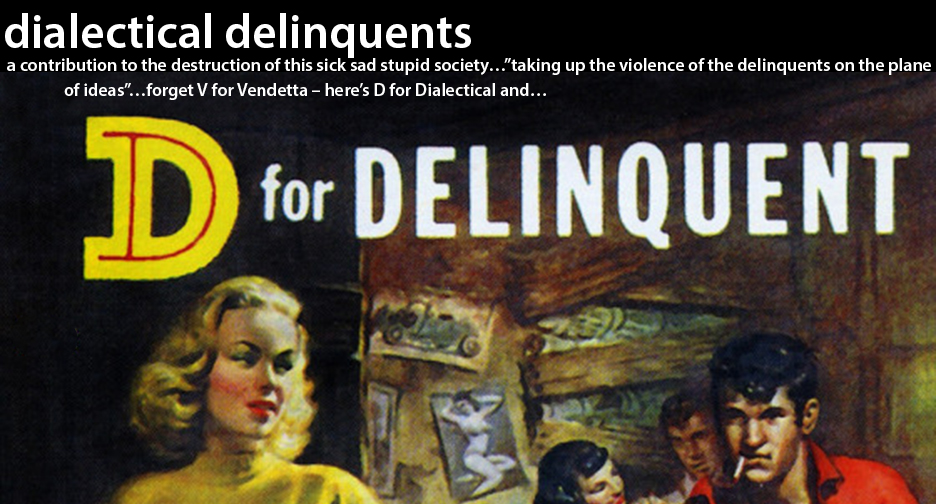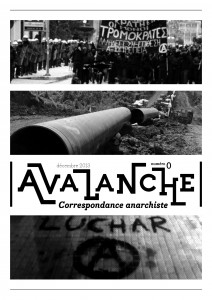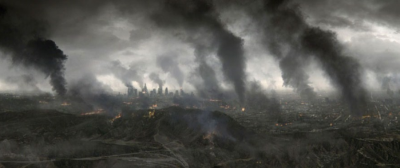Publié sur Bay of Rage

Ce mardi 24 Octobre, la deuxième semaine d’Occupy Oakland eut passé, et le charisme de la marche de Samedi dernier s’estompa alors qu’un raid policier était imminent. Au-delà de la spéculation répandue que la ville et la police planifiaient la destruction de la Place Oscar Grant, il y avait quelques indices laissant croire que ce lundi serait leur moment choisi. Il y a que la ville avait issu des lettres à des commerces sélects autour de la place sous-entendant de l’activité policière au cours de la journée à venir. En plus, la ville semble avoir forcé les pompiers à saisir les réservoirs à propane (nous empêchant donc de cuisiner sur place).
Avant les balles de plastique et les grenades chimiques, la centaine d’arrestations et les nuages de foule enragée paralysant le centre-vile d’Oakland, on se barricadait dans la joie et l’impatience. Ce fut la nuit des vidanges. Les rues déjà désolées entourant la Place Oscar Grant furent rapidement nettoyées de quelconque débris pouvant agir pour repousser la police. Près d’une centaine de barricades,sous verrou près de l’Hôtel de Ville, furent libérées et placées stratégiquement autour du camp. Des infos arrivèrent lentement : plusieurs unités de police, de plusieurs agences jusqu’à Vacaville, se mobilisaient en direction de la Place en moto ou par le BART (métro). Des querelles éclatèrent à l’occupation – certaines appelant à une stratégie unifiée de déjense alors que d’autres continuèrent de barricader, faire des graffitis et faire des projectiles avec le pavé. Éventuellement, autour de 4h du matin, les sirènes entendues au loin se révélèrent celles de plusieurs dizaines d’unités de police en formation, donnant des ordres de dispersion avant d’attaquer notre camp.
Il y avait de l’espoir mais peu de certitudes que les gens de la place et leurs barricaes purent repousser la police, ou seulement défendre le camp. Quand les phares des hélicos de police balayèrent la place, les gens déjà nerveux furent pris de panique. Il ne fallut qu’un momemt pour réaliser que rester sur la place était désespéré. Ceux qui prirent position pour rester cloués à terre furent la cible de projectiles, matraques et arrestations. Ce fut une scène de panique, d’oppression et de défaite. Pour l’instant, la lutte pour la place était perdue et la plupart des occupants se dispersèrent.
Loin des barrages de police, plusieurs cherchèrent à se rassembler, d’autres arrivèrent en répondant aux SMS d’urgence et appels téléphoniques – ils se retrouvèrent tous-tes coin 14ième et Franklin, à une rue à l’est de la place. Pour la police c’était clair que cette foule grandissante ne serait pas réduite à l’état de spectateurs impuissants. Laissant le trottoir pour prendre la rue dans le trafic matinal, la foule remplit l’intersection de slogans haineux à l’égard de la police. L’impatience et la soif de vengeance étaient ahurissantes. Ç’eut grandit à presque 200 personnes lorsque qu’une unité de police à moto intervint pour intimider et disperser la foule. Changeant leurs habits et retournant des bacs de vidange, le group fit cap dans la direction opposée. Cris d’excitation, insultes et un orchestre de vacarme et de chocs envahirent les rues. La police s’était préparé à une attaque sur la place, mais pas à ses conséquences. De 5 à 6 heures du matin les rue à l’est de la place résonnèrent avec familiarité pour certains et comme une émotions inattendue pour d’autres.
Une décision offensive pas la ville et ses alliés a donné l’opportunité à ceux exposés à son autorité de plus en plus insensée. Mardi matin, la ville se mit à activement décourager les gens à travailler dans le centre-ville. Malgré cette recommandation officielle, on pouvait entrevoir les gardes de sécurité, voirie et autre employés de service se déclarer absents au travail de leur propre initiative. Quelqu’un initia une campagne pour destituer la maire Jean Quan. Des Tweets et SMS explosèrent avec l’annonce de se rassembler à la Bibliothèque d’Oakland à 16h. Le Conseil des travailleurs du Comté d’Alameda dénoncèrent comme d’autres syndicats les actions de la police et de la ville.
Ce qui suivrait serait soit un spectacle ou une véritable rébellion. Oakland, une fois de plus, s’ouvrit aux libertés trouvées dans le champ des possibles…
Bibliothèque. Émeute. La suite
Mardi, de 16h à minuit
12 heures plus tard, le plan de contingentement approuvé par l’assemblée générale en cas d’un raid est mis en place. À 16h, près de 1000 personnes s’assemblent à la bibliothèque centrale d’Oakland pour entendre des discours inspirants et des condamnations envers la police. Nul ne pouvait ignorer le sentiment général d’animosité envers ceux responsables de l’expulsion de la veille. Quelque chose de spectaculaire était pour arriver ce soir.
Après les élocutions, les gens ont marché à la prison du centre-ville en support aux arrêtés-es la nuit précédente. Le long de la route, la marche a croisé deux lignes de police séprées, mais à le troisième, alors que la marche était rendue à une rue de la prison, la police a tenté de la repousser. Les policiers ont saisi deux personnes du devant de la marche et les a jetées au sol. Voyant la scène, la foule a immédiatement entouré les flics, hurlant contre eux, essayant de saisir leurs camarades et de les libérer. Les manifestants ont poussé et ont projeté de la peinture. Pendant que la tension continuait à monter, la police a vu qu’elle livrait une bataille perdue d’avance, or ils ont amené les renforts avec du gaz irritant et des flashbangs pour disperser la foule. Au milieu du chaos, ceux arrêtés ont été menottés par les porcs et chargés dans un fourgon. Un des arrêtés a été abusé, et en en prison fut appelé par des insultes racistes et physiquement harcelé. Et après cela, comment est-ce possible de ne pas détester la police ?

À travers toutes les arrestations des résistants Occupy Oakland, nous démontrons la solidarité avec les otages de l’État dans une multitude de manières, émotionellement et physiquement. La marche a regroupé et a procédé en longeant la prison en faisant le bruit pour rendre ceux à l’intérieur -chacun d’entre eux- conscients du fait que la marche était pour eux, dans la pleine solidarité. Un camarade arrêté la nuit précédente a dit, une fois libéré de prison, que c’était une des choses les plus belles et les plus puissantes qu’il ait jamais vu. D’entendre et de voir 1000 personnes faire du bruit en dehors, montrant leur solidarité avec ceux sur l’intérieur. Solidarity means « attack »!
La marche est revenue à la Place Oscar Grant, où le groupe a tenté de reprendre la place. Après 20 minutes de confrontration avec la police, coin 14ième et Broadway, des coups de gaz irritants et des flashbangs ont été employés de nouveau (on a compté environ sept cas de recours à ces moyens par la police afin d’essayer de disperser la foule. La foule n’a pas pour autant détérioré , ni cette fois ni à tout autre moment).
C’était seulement le début…
Ce premier gazage majeur fut également l’incident où un vétéran a été frappé à la tête avec un capsule métallique de gaz irritant et l’a soit assommé ou mis en état de choc nerveux; il reposait au sol face à la police avec ses yeux grand ouverts, figé et ne répondant pas à quoique ce soit. Les gens ont immédiatement couru à lui pour le mettre à l’écart, alors que la police a jeté un autre flashbang directement sur lui et ceux qui sont allé à son aide (et où était la très sainte Croix Rouge?). Ça vaut la peine de le répéter : la police a jeté une grenade flash directement sur quelqu’un qui reposait immobile au sol, dispersant la foule qui essayait de le prendre hors de danger. Le manifestant blessé a été par la suite emmené à l’hôpital avec une fracture du crâne et est actuellement un état critique, sur le point de subir une chirurgie. Beaucoup d’autres ont été blessés. Pas tous ont rapporté leurs blessures pour des raisons évidentes.
À ce point, la marche avait doublé à plus de 2000 personnes. Le groupe a marché sur Snow Park pour s’y regrouper, mais peu de temps passa avant que la foule retourne sur la place Oscar Grant. Dans ce qui devint une norme de la nuit, la marche a confronté la zone maintenant militarisée faisant face à une pluie de flashbangs et de gaz CS faisant tomber des gens et causant des vomissements. Mais ç’a pas arrêté personne; ça a au contraire seulement galvanisé la foule encore plus et a incité beaucoup à lsortir de chez eux pour se diriger le centre ville et joindre la résistance.
La marche commença à 17h et dura jusqu’à tard dans la nuit avec plus de 6 heures de marches en serpent des confrontations presque constantes avec la police partout dans le centre ville.
Vers la fin de la nuit, les gens ont commencé à craindre d’être coincés par la police, alors certainsse sont chargé d’installer des barricades autour des intersections environnantes. Cela donnerait le temps aux personnes de réair avant d’être pris, la latitude suffisante pour soit contre-attaquer ou battre en retraite. Les barricades comprenaient les propres barricades de la ville qui avaient été installées dans tout le secteur, les bacs à déchets (certains de ces derniers ont été enflammés pour contrer les effets prolongés des gaz CS présents dans tout le centre ville et pour causer plus de problème pour la police si elles osaient intimider ou assaillir la foule).
Alors que la nuit continuait, le groupe s’est lentement dispercé de lui-même, confiant que ce combat n’était pas près d’être terminé.
Reprise de la Place Oscar Grant
Mercredi, de 18h à minuit
La nuit précédente, il était évident pour tous que les gens allaient reprendre la Place Oscar Grant. À cette heure, la police était nulle part autour de la place. La seule chose restant de l’expulsion, une barrière en métal érigée autour du lieu de l’occupation. Mais ça ne dura qu’un bref moment. Avant que l’Assemblée générale ait même démarré, les gens ont spontanément commencé à démolir la barrière. Au début, une certaine « police de la paix », tentant de les forcer à arrêter en vomissant quelque chose au sujet de la non-violence; ce qui fut naturellement vain alors que la clôture était promptement démolie.
L’assemblée générale qui se déroula au cours de cette nuit fut la plus grande à ce jour pour #OccupyOakland, avec plus de 2000 participants-es. Vu la largeur de l’AG, tout a pris plus de temps, mais il y a eu une proposition qui a eu la valeur de toutes les autres. Après des annonces que plusieurs occupations à travers les États-Unis participaient à des marches de solidarité, et que les gens au Caire étaient pour marcher sur la placeTahrir ce vendredi en disant que « le Caire et Oakland sont comme les doigts d’une main » la proposition de déclarer une grève ce Mercredi 2 novembre a été passée avec une majorité écrasante (97%).
À la suite de l’AG, des gens ont annoncé que OccupySF était à son tour menacé d’expulsion. Un appel a été fait pour que des personnes se rendent à San Francisco et concrétisent leur solidarité. Mais ça ne put se produire, car avant que les gens se rendent seulement au BART, la station fut fermée. Frustrés, le petit groupe de support a pris les rues d’Oakland, où le reste de l’AG, encore dans les environs, s’est joint. La marche a immédiatement pris la direction de la prison pour montrer de la solidarité avec ceux encore à l’intérieur. Tout le monde pouvait apercevoir les mains des incarcérés et les lumières clignotantes de leurs cellules, signalant qu’ils recevaient notre message.
Durant les heures qui suivirent, le groupe marcha parmi le centre-ville d’Oakland avec aucune interférence policière. Il y avait des rumeurs que la police se positionnait pas loin, mais ils ne se sont jamais fait plus visibles que par quelques voitures à l’avant ou l’arrière. Probable qu’à lumière de la nuit dernière, ils ont réalisé comment ils ont raté leur coup. Cette nuit-ci, c’est nous qui avons pris le contrôle de la rue. Ça c’est finalement terminé à la Place Oscar Grant, avec plein de gens célébrant et s’assoyant en plein milieu du coin de la 14ième et Broadway (la principale intersection du centre-ville), avec aucune tentative de dispersion de la part des flics.
À seulement une semaine de la grève générale sur laquelle nous nous sommes entendus, il y a beaucoup de travail à faire et beaucoup de contacts à établir ou renforcir. Des gens ont commencé à rebâtir le camp sur la place occupée, alors que d’autres profitent du moment pour se reposer, et se regrouper pour ce qui reste à venir…
Soyez prêts, Oakland, ça va brasser….
Traduit par Anabraxas
UPDATE: Oakland, all downtown banks shut down in face of protests!
(Sur les occupations en cours à travers l’Europe:)




































